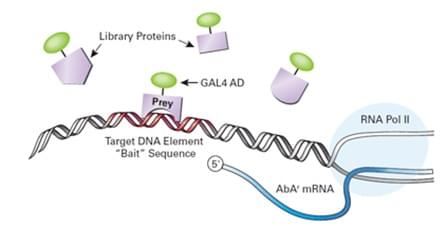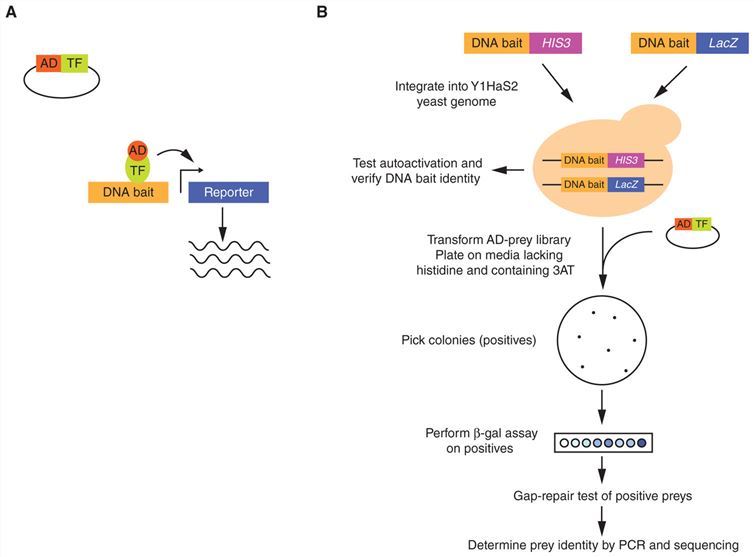Creative Biolabs has established a series of technical platforms that monitor and detect protein-protein, protein-DNA, and protein-RNA interactions, particularly yeast hybrid systems. Among them, yeast one-hybrid (Y1H) assay is increasingly attracting more attention in analyzing the interaction between protein and nucleic acid. The Y1H is usually used to identify protein-DNA interactions (PDIs) with short cis-regulatory elements and with longer and more complex DNA fragments, for instance, promoters and enhancers. Creative Biolabs provides Y1H services including Y1H library construction and screening.
Y1H Synopsis
Precise gene expression plays a pivotal role in cell development, homeostasis, as well as in response to environmental cues. It is largely controlled by the specific binding of heterologous transcription factors (TFs) to the regulatory DNA sequence. TFs consist of 5-10% of the protein-coding genes in most organisms, also referred to the sequence-specific DNA-binding factor. They are actually proteins responsible for regulating transcriptional rates of genetic information from DNA to mRNA. PDIs can be experimentally identified by many different approaches, and the Y1H assay is regarded as a gene-centered method to confirm the repertoire of TFs that bind a DNA region of interest.
 Fig.1 Canonical yeast one-hybrid (Y1H).
Fig.1 Canonical yeast one-hybrid (Y1H).
Y1H is a powerful approach to rapidly identify proteins that can interact with a specific DNA regulatory region of interest. This technique is employed to ascertain “prey” molecules of TFs bind to a DNA fragment of interest that is known as “bait”. The process of Y1H involves that plasmids encoding TFs introduced into a yeast bait strain in which the DNA fragment is integrated upstream of one or more reporter genes, and subsequently the activation of the reporters indicates that a TF-DNA interaction has occurred. The name of one hybrid in yeast is derived from these plasmids, which express each TF as a hybrid protein fused to the activation domain (AD) of yeast Gal4.
Principles of Y1H
In this assay, there are two major components included. One, a reporter is constructed in which a bait DNA is cloned upstream of reporter genes, and the other, a plasmid that expresses a prey hybrid protein comprises a TF fused to the AD of the yeast TF Gal4. Both constituents are introduced into a budding yeast strain, and the bait part is used to “fish” for the interacting prey. If the hybrid TF binds the DNA of interest, the AD will activate the expression of reporter genes. In conclusion, Y1H is an accessible technology to detect PDIs between TFs fused to the Gal4 AD (AD-TF “prey”) and a specific DNA sequence (DNA “bait”).
 Fig.2 The principles underlying the yeast one-hybrid technique and the pipeline for library screening.
Fig.2 The principles underlying the yeast one-hybrid technique and the pipeline for library screening.
Y1H is based on the interaction of a TF with a DNA fragment upstream of reporter genes. Multiple reporters have been served to detect the interaction in Y1H assays, such as auxotrophic genes of HIS3, LEU2, URA3, and TRP1 that enable growth in the absence of histidine, leucine, uracil, and tryptophan, respectively, as well as LacZ that codes for the bacterial enzyme beta-galactosidase, which is detectable in colorimetric tests.
Advantages of Y1H
Although Y1H results are subject to false-negative or false-positive interactions as with any methodology, there are several advantages cannot be negligible as follows.
Ultimately, the comprehensive detection of PDIs that drive gene regulation requires a combination of complementary means, such as chromatin immunoprecipitation (ChIP). Remarkably, our combination of the one-hybrid and two-hybrid approaches can increase the stringency and reliability of results obtained from two-hybrid assays alone. With the assistance of Creative Biolabs, scientists around the world will dissect more information about protein-nucleic acid interactions and facilitate their understanding of gene expressions and regulations.
All listed services and products are For Research Use Only. Do Not use in any diagnostic or therapeutic applications.